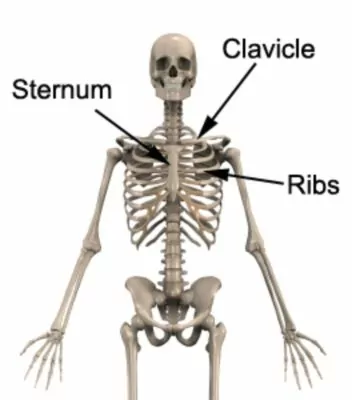Sternum Anatomy (Breast bone)
Updated:
The sternum, also known as the breastbone, is an essential part of the skeletal system that connects the ribs at the front of the chest and helps to protect vital organs like the heart and lungs. In this article, we will explore the anatomy of the sternum, including its structure, function, and related injuries.
An Overview of Sternum Anatomy
The sternum is a long, flat T-shaped bone located in the center of the chest. It is connected to the ribs on either side and each clavicle (collarbone) at the top on each side. The sternum consists of three main parts – the manubrium, body and xiphoid process. The manubrium is the top part of the sternum and is shaped like a wide, horizontal blade. The body is the middle part of the sternum and is shaped like a long, narrow blade. The xiphoid process is the small, thin, and pointed bottom part of the sternum.

Structure and Function of the Sternum
The sternum has various bony landmarks that serve as attachment sites for muscles and ligaments. These include the jugular notch, which is located at the top of the manubrium, and the sternal angle, which is the junction between the manubrium and body of the sternum. The costal notches are small grooves located on either side of the sternum where the ribs attach. The xiphisternal joint is where the xiphoid process meets the body of the sternum.
The sternum plays an essential role in the respiratory system by providing support for the ribcage and protecting the heart and lungs. It also serves as an attachment site for several muscles, including the pectoralis major, which is the main muscles responsible for moving the upper arm across the chest (horizontal flexion). The sternum also plays a crucial role contributing to optimal skeletal posture and spinal alignment.
Injuries of the Sternum
Injuries to the sternum can occur due to trauma, accidents, or repetitive strain. Common injuries include sternal fractures, contusions, sternoclavicular joint sprain and sternal instability. Symptoms of these injuries include pain, swelling, and difficulty breathing or moving the shoulder. In severe cases, injury to the sternum can result in damage to the heart and lungs.
Sternum Anatomy – Conclusion
The sternum is an important part of the skeletal system, connecting the ribs and protecting the vital organs in the chest. Understanding the anatomy of the sternum can help prevent and manage injuries, allowing for optimal function and performance of the body. If you experience any pain or discomfort in your sternum, consult a physiotherapist or medical professional promptly.
References:
“Sternum Anatomy” by Healthline (https://www.healthline.com/human-body-maps/sternum#1)
“Anatomy of the Sternum (Breastbone)” by TeachMeAnatomy (https://teachmeanatomy.info/thorax/bones/sternum/)

Link to this Page
If you would like to link to this article on your website, simply copy the code below and add it to your page:
<a href="https://physioadvisor.com.au/health/anatomy/bones/sternum-anatomy-breast-bone”>Sternum Anatomy (Breast bone) – PhysioAdvisor.com</a><br/>Learn about the anatomy of the sternum (breast bone) on PhysioAdvisor including bony structure, function and injuries.
Return to the top of Sternum Anatomy (Breast bone).
